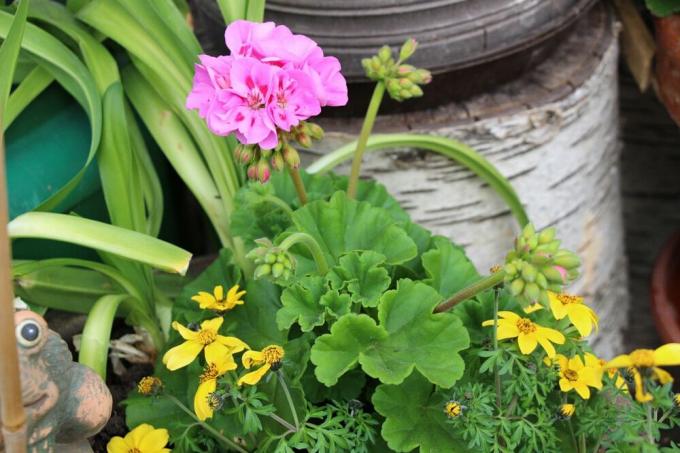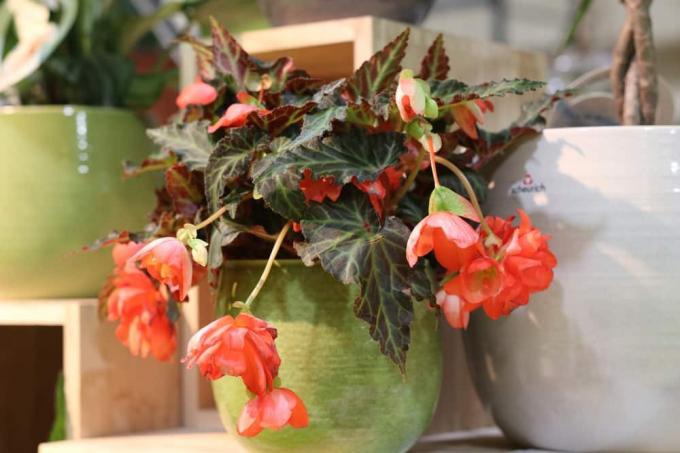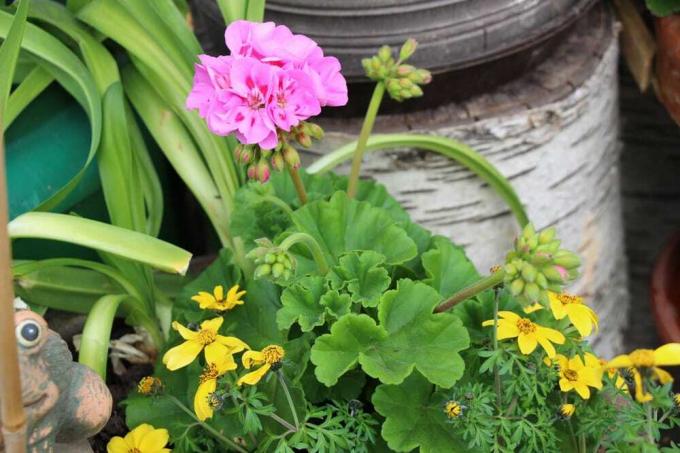

Table of contents
- guidance and ideas
- Geraniums: The classic for the window box
- Herbs in the balcony box
- Zen garden for total relaxation
- Worth knowing shortly
In principle, anything is possible in the balcony box. As long as the location, soil used and box size match the chosen planting, everything that grows outdoors can also grow in the window box. However, whether this is desired, whether the plants meet personal requirements and stylistically match the box, is another question.
guidance and ideas
A balcony box can contain quite a lot - depending on the location, the volume and the care a small herb garden thrives in it just as well as salads, classic flowering plants or even exotics. The transition from balcony box to planter and pot is fluent, because thanks to special Nowadays, almost every container can be attached to hanging devices inside or outside on the balcony railing attach. A balcony box is no longer just a classic balcony box, and what grows in it is a question of faith. Therefore, very different ideas are presented here as to how a balcony box planting can look like - with and without flowers, edible or not, classic or unusual.
Geraniums: The classic for the window box

When it comes to planting balcony boxes, geraniums are a classic. They are easy to care for, bloom early and long, they are standing and hanging and in all colors. Geraniums overwinter indoors, by autumn they should be brought indoors. In the spring you wake them up from hibernation by placing them in the light and letting them spend the first warm days outside. Before that, however, they should be repotted in fresh soil. As soon as they are cast, they will sprout again from the hive. However, geraniums are quite sensitive to cold: you can only spend the night outside when there is no more frost. Geraniums want soil or a substrate that doesn't hold too much water around the roots or they will suffer damage. And they want sun, as much of it as possible, and whenever possible. A shady balcony is not very suitable for geraniums.
Geraniums need a lot of water. Each plant consumes four to six liters a week, and depending on the size of the window box and the number of plants in it, quite a bit comes together. And the same goes for the fertilizer – geraniums need a lot of it. Once a week you should fertilize with the irrigation water so that the plants really bloom long and beautifully. Three varieties of geraniums play a role in window box planting: the normal geraniums that grow upright, the Hanging geraniums that hang down from the pot or box, and the scented geraniums, which have rather inconspicuous flowers, but intense smell. The latter are particularly interesting because they keep pests, wasps, hornets and other insects away from the balcony. The animals do not like the intense smell of the oily leaves and avoid the immediate vicinity of the plants.
Herbs in the balcony box

It is clear that you can no longer get by in the kitchen with just salt and pepper. Many herbs have become indispensable in German cuisine, from parsley to chives and Lemon balm over the more Mediterranean herbs like rosemary, basil, thyme, lavender, and oregano Marjoram. All this not only grows outdoors, but also thrives well in balcony boxes. Parsley does not like direct sun and is relatively sensitive to wet roots (as is dill), while the Mediterranean herbs get along well with the blazing sun, need a lot of water (especially the lavender) and are beautiful in summer bloom. The herbs are also allowed to bloom, because the insects native to the area pollinate them, which means that the balcony box planting quickly becomes a sure-fire success. The herbs are not frost-resistant, so they should definitely be overwintered indoors in a cool, not too dark place. Seeds that have fallen out will germinate next spring - the soil should not simply be completely replaced in spring, but rather carefully supplemented.
Many herbs are only annuals, basil for example, as well as dill. Others, like rosemary, can bring joy for many years. Herbs that are consumed require a special herbal fertilizer that is non-toxic. If you value organic quality, you should have the appropriate herbal soil in the window box and pay attention to organic seeds and organic fertilizer. Some herbs, like chives, multiply very quickly and need to be divided regularly to keep them from overgrowing the entire box and getting in the way.
Zen garden for total relaxation
Zen gardens appear simple, plain, elegant. They radiate calm. They let everyday life sink in and take the viewer into a completely foreign world. Apart from that, Japan is just trendy. You can also bring the Zen garden into the balcony box. For this you need simple, wooden boxes that are lined with foil on the inside. They are filled with substrate or soil (depending on the planting). This base is covered with plain basalt gravel or white marble gravel after planting. If you opt for white marble gravel, you should wash the stones well before filling the boxes, because they usually contain a lot of dust, which is not good for the planting. Depending on mood and preference, different types of bonsai are planted. The respective care can be requested in specialist shops, the differences are quite large. For the balcony box planting, however, more robust plants are to be preferred.
What makes a Zen garden special is the detailed design: the world is represented on a small scale, so to speak, you create an artificial one Image of nature that should look as natural as possible without losing its man-made, perfectionist character lose. A small grove does quite well, a few larger stones representing rocks or mountains, a few low plants, a flowering accent in one of the boxes. However, the areas strewn with fine stones always dominate, which can also be shaped as desired. When you first fill the balcony boxes, you should make sure that there are more stones in the middle, a small hill is formed, because the stones will sag quickly. A small supply for refilling is also recommended. However, the Far Eastern boxes unfold their perfect effect in a rather empty environment, on a balcony that appears tidy, clean and tidy, with little or no furniture.
Worth knowing shortly
There are beautiful balcony box plants for every season. Many types of plants thrive wonderfully in window boxes. With such beautiful colorful plants you bring the south home. The beautiful season already begins in spring, when the days are getting brighter and the sun is coming out more and more. You want to be able to look at a colorful flower splendor on the balcony:
- From February you can already spring light flower plant. This flower looks like a giant one visually crocus. Since this plant can survive frosty nights, it is ideal for this time of year. This beautiful flower blooms purple-pink from February to April.
- With the crocus you actually say goodbye winter. The crocus comes in many varieties and colors. Some bloom in spring and some in autumn, the flowers are cup-shaped.
- In the summer you can beautiful geraniums plant in balcony boxes. They are also available in different types and colors. So you can mix and match as you like. The blooms will cause a stir as they are gorgeous all summer long.
- Just as happy to be fuchsias preferred for balcony boxes. They are easy to care for and breathtakingly beautiful to look at. There are also different varieties and colors of fuchsias, so that you can combine them wonderfully.
Geraniums and fuchsias bloom well into the fall. If you have the opportunity, you can too hibernate permit. You cut them back and put them in a sheltered place, e.g. B. the cellar. In any case, the place should be frost-free and dark. In January you can bring these plants back into the light and slowly nurture them back before you can plant them again in May.
 garden editorial
garden editorial I write about everything that interests me in my garden.
Learn more about balcony plants

Eisbegonia, Begonia: care instructions from A - Z
The ice begonia is one of the most popular bedding plants, because they are characterized by their robustness and willingness to flower. When caring for ice begonias, there are a few points to consider when fertilizing and watering. As a houseplant, it is perennial and can be overwintered.

Begonia location: 3 important criteria
Begonias are easy-care plants. However, so that they can thrive and you can actually enjoy them, the location must be right. And that means above all: no direct sunlight, but shade or semi-shade. In addition, the soil should be as moist as possible.

Blue fan flower, Scaevola aemula: care from A - Z
Are you looking for an easy-care and robust flower for the balcony? Then the blue fan flower might just be the right plant for you!

16 popular hanging plants and how to care for them
Hanging plants aren't always a sad sight. At least not when nature intended it that way. Their tendrils weave a new dress on boring balcony walls in no time. Whether fast-growing, green, colorful or just easy to care for, every wish will be fulfilled.

13 balcony plants for sunny south-west balconies balcony flowers
A balcony with leafy or flowering plants delights both the heart and the eye. However, not every balcony plant is suitable for every balcony, because every plant makes specific demands on the location. We have put together for you which plants are particularly suitable for a south-west balcony.

Scented geraniums: care, propagation and overwintering scented geranium
Is it the lush growth? The brightly colored flowers? Or is it its beguiling scent that makes the scented geranium our favourite? Does she have any other trump cards? Yes! As beautiful as she is, she is also undemanding. Your care succeeds!


